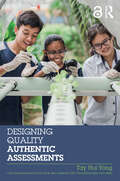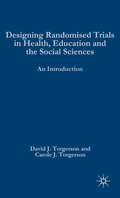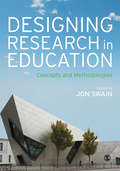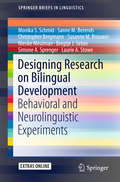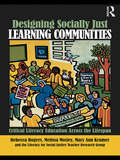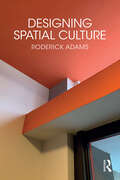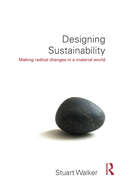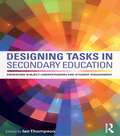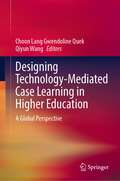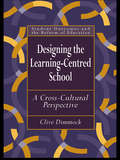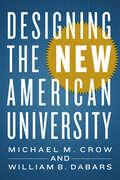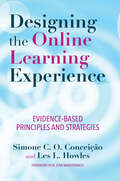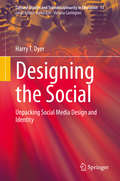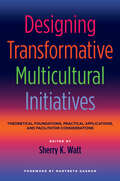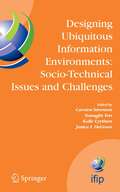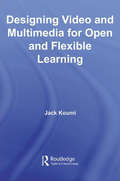- Table View
- List View
Designing Quality Authentic Assessments (Assessment in Schools: Principles in Practice)
by Tay Hui YongThis book examines the principles and practice of authentic assessment. It seeks to answer the following questions. What is authentic assessment? How is authentic assessment different from 'performance assessment' or 'alternative assessment'? How can authentic assessment support learner-centred education, especially when a performance-oriented culture favours pen-and-paper examinations? The book is structured into two major parts. The first, 'Principles of authentic assessment design', provides readers with a conceptual explanation of authenticity; the principles for designing quality authentic assessments for valid evidence of student learning; and guidance about how to develop quality rubrics to structure assessment tasks. The second part of the book, 'Theory into practice' provides examples developed by teachers to demonstrate an understanding of authentic assessment. The subject areas covered include humanities, languages, mathematics, sciences, character and citizenship. Two case studies are discussed to demonstrate how authentic assessment can be used to comprehensively address key learning objectives in a variety of curriculum contexts. This book provides practitioners with concrete examples on how to develop authentic assessment to suit their context and also enhance their students’ learning. The book will also enable teachers to face assessment challenges present in our changing world.
Designing Quality Authentic Assessments (Assessment in Schools: Principles in Practice)
by Tay Hui YongThis book examines the principles and practice of authentic assessment. It seeks to answer the following questions. What is authentic assessment? How is authentic assessment different from 'performance assessment' or 'alternative assessment'? How can authentic assessment support learner-centred education, especially when a performance-oriented culture favours pen-and-paper examinations? The book is structured into two major parts. The first, 'Principles of authentic assessment design', provides readers with a conceptual explanation of authenticity; the principles for designing quality authentic assessments for valid evidence of student learning; and guidance about how to develop quality rubrics to structure assessment tasks. The second part of the book, 'Theory into practice' provides examples developed by teachers to demonstrate an understanding of authentic assessment. The subject areas covered include humanities, languages, mathematics, sciences, character and citizenship. Two case studies are discussed to demonstrate how authentic assessment can be used to comprehensively address key learning objectives in a variety of curriculum contexts. This book provides practitioners with concrete examples on how to develop authentic assessment to suit their context and also enhance their students’ learning. The book will also enable teachers to face assessment challenges present in our changing world.
Designing Randomised Trials in Health, Education and the Social Sciences: An Introduction
by D. TorgersonThe book focuses on the design of rigorous trials rather than their statistical underpinnings, with chapters on: pragmatic designs; placebo designs; preference approaches; unequal allocation; economics; analytical approaches; randomization methods. It also includes a detailed description of randomization procedures and different trial designs.
Designing Research in Education: Concepts and Methodologies (PDF)
by Dr Jon SwainThis is a clear introduction to the methodological and philosophical debates in the field of education research. It sets out the key ideas, questions, and dilemmas which inform all research and then, through the careful use of case studies and practical advice from experienced researchers, grounds them in the specific concerns of education and educational studies. Written by experienced academics and teachers the book links broad philosophical principles with practical strategies for designing and conducting ethical and effective research. Perfect for postgraduate students planning their own research in education this book will help you to: · Understand the philosophical foundations of your work. · Conceptualise and refine your research question. · Pick the right methodology for your research. · Embed ethical considerations throughout your research. This book is an ideal companion for any postgraduate student or early career academic conducting research across education and educational studies.
Designing Research in Education: Concepts and Methodologies
by Dr Jon SwainThis is a clear introduction to the methodological and philosophical debates in the field of education research. It sets out the key ideas, questions, and dilemmas which inform all research and then, through the careful use of case studies and practical advice from experienced researchers, grounds them in the specific concerns of education and educational studies. Written by experienced academics and teachers the book links broad philosophical principles with practical strategies for designing and conducting ethical and effective research. Perfect for postgraduate students planning their own research in education this book will help you to: · Understand the philosophical foundations of your work. · Conceptualise and refine your research question. · Pick the right methodology for your research. · Embed ethical considerations throughout your research. This book is an ideal companion for any postgraduate student or early career academic conducting research across education and educational studies.
Designing Research on Bilingual Development: Behavioral and Neurolinguistic Experiments (SpringerBriefs in Linguistics)
by Monika S. Schmid Sanne M. Berends Christopher Bergmann Susanne M. Brouwer Nienke Meulman Bregtje J. Seton Simone A. Sprenger Laurie A. StoweThis volume offers an in-depth description and discussion of research design for a large-scale investigation of bilingual development. It introduces and justifies a range of theoretical and methodological innovations, discusses some of the problems that come with these and proposes practical solutions. The present volume introduces a research design intended to capture a wide range of linguistic data, elicited by means of behavioral tasks, neuroimageing data and free speech from both second language learners and first language attriters of two languages (Dutch and German) representing a wide range of language combinations and ages of onset. Gathering and analyzing such a range of data comes with a multiplicity of problems, many of them linked to the fact that similar tests have to be designed across a range of languages and measurements will have to occur in various locations. The current volume presents a research design appropriate to these questions, discussing the methodological challenges of such a study. It offers advice on how to construct experimental materials which are parallel across different languages set up a protocol for additional measures which can be applied across a wide range of participants combine data from different labs when using different ERP equipment and different eyetrackers.
Designing Socially Just Learning Communities: Critical Literacy Education across the Lifespan
by Rebecca Rogers Mary Ann Kramer Melissa Mosley The Literacy for Social Justice Teacher Research GroupDemonstrating the power and potential of educators working together to use literacy practices that make changes in people's lives, this collaboratively written book blends the voices of participants in a teacher-led professional development group to provide a truly lifespan perspective on designing critical literacy practices. It joins these educators’ stories with the history and practices of the group - K-12 classroom teachers, adult educators, university professors, and community activists who have worked together since 2001 to better understand the relationship between literacy and social justice. Exploring issues such as gender equity, linguistic diversity, civil rights and freedom and war, the book showcases teachers’ reflective practice in action and offers insight into the possibilities and struggles of teaching literacy through a framework of social justice. Designing Socially Just Learning Communities models an innovative form of professional development for educators and researchers who are seeking ways to transform educational practices. The teachers' practices and actions – in their classrooms and as members of the teacher research group – will speak loudly to policy-makers, researchers, and activists who wish to work alongside them.
Designing Socially Just Learning Communities: Critical Literacy Education across the Lifespan
by Rebecca Rogers Mary Ann Kramer Melissa Mosley The Literacy for Social Justice Teacher Research GroupDemonstrating the power and potential of educators working together to use literacy practices that make changes in people's lives, this collaboratively written book blends the voices of participants in a teacher-led professional development group to provide a truly lifespan perspective on designing critical literacy practices. It joins these educators’ stories with the history and practices of the group - K-12 classroom teachers, adult educators, university professors, and community activists who have worked together since 2001 to better understand the relationship between literacy and social justice. Exploring issues such as gender equity, linguistic diversity, civil rights and freedom and war, the book showcases teachers’ reflective practice in action and offers insight into the possibilities and struggles of teaching literacy through a framework of social justice. Designing Socially Just Learning Communities models an innovative form of professional development for educators and researchers who are seeking ways to transform educational practices. The teachers' practices and actions – in their classrooms and as members of the teacher research group – will speak loudly to policy-makers, researchers, and activists who wish to work alongside them.
Designing Spatial Culture
by Roderick AdamsDesigning Spatial Culture investigates a powerful experiential dialogue formed between the habitation of space and a diversified cultural realm. This creative proposition binds and positions human activity and experience framing its histories, currency and future. Whilst the book distinguishes between the conditions of the existing urban/ architecture/ interior canon, it embraces a new agency of space, showcasing the encounters, assemblies and designs that shape human behaviours and the cultural forms of the built environment. Using authoritative case studies, the book examines many locations and spaces, ranging from new urban landscapes, historical domestic spaces and contemporary architecture. It embraces the most lavish and flamboyant to the most simplistic and minimal, establishing a connected cultural narrative. The book shifts the focus in the spatial realm from an object-based experience (where space is filled with things) to a more complete immersive experience (combining physical and digital). A key part of this exploration is the relationship between the architecture and the interior which is often the most predominant spatial experience and fundamental to the understanding spatial experience and existing cultures. Without the architectural enclosure, the interior would lose its site context and structure for its existence. Without an interior, architecture would not fully develop an engaging spatial experience for the user. The book rationalises this through extended use of a spatial probe which documents and summarises an evidence-based research project capturing spatial culture data from a predominantly domestic setting. The book is essential reading for students and researchers in architecture, interior design and urban design.
Designing Spatial Culture
by Roderick AdamsDesigning Spatial Culture investigates a powerful experiential dialogue formed between the habitation of space and a diversified cultural realm. This creative proposition binds and positions human activity and experience framing its histories, currency and future. Whilst the book distinguishes between the conditions of the existing urban/ architecture/ interior canon, it embraces a new agency of space, showcasing the encounters, assemblies and designs that shape human behaviours and the cultural forms of the built environment. Using authoritative case studies, the book examines many locations and spaces, ranging from new urban landscapes, historical domestic spaces and contemporary architecture. It embraces the most lavish and flamboyant to the most simplistic and minimal, establishing a connected cultural narrative. The book shifts the focus in the spatial realm from an object-based experience (where space is filled with things) to a more complete immersive experience (combining physical and digital). A key part of this exploration is the relationship between the architecture and the interior which is often the most predominant spatial experience and fundamental to the understanding spatial experience and existing cultures. Without the architectural enclosure, the interior would lose its site context and structure for its existence. Without an interior, architecture would not fully develop an engaging spatial experience for the user. The book rationalises this through extended use of a spatial probe which documents and summarises an evidence-based research project capturing spatial culture data from a predominantly domestic setting. The book is essential reading for students and researchers in architecture, interior design and urban design.
Designing Sustainability: Making radical changes in a material world
by Stuart WalkerWhat is the relationship between design, sustainability, inner values and spirituality? How can we create designs that provide a convincing alternative to unsustainable interpretations of progress, growth, consumerism and commercialism? Building on the arguments first advanced in his widely acclaimed books Sustainable by Design and The Spirit of Design, Stuart Walker explains how we can achieve the systemic changes needed to address the challenges of sustainability. Challenging common assumptions about the nature of our contemporary material culture and its relationship to human flourishing, the author introduces approaches to design that draw inspiration from nature, summon the human imagination and create outcomes which are environmentally responsible and socially just, as well as meaningful and enriching at a personal level. Offering a unique and original contribution to this vital debate, Designing Sustainability is destined to become essential reading for students on courses in design and sustainability and for design practitioners looking for a deeper, more meaningful basis for their work.
Designing Sustainability: Making radical changes in a material world
by Stuart WalkerWhat is the relationship between design, sustainability, inner values and spirituality? How can we create designs that provide a convincing alternative to unsustainable interpretations of progress, growth, consumerism and commercialism? Building on the arguments first advanced in his widely acclaimed books Sustainable by Design and The Spirit of Design, Stuart Walker explains how we can achieve the systemic changes needed to address the challenges of sustainability. Challenging common assumptions about the nature of our contemporary material culture and its relationship to human flourishing, the author introduces approaches to design that draw inspiration from nature, summon the human imagination and create outcomes which are environmentally responsible and socially just, as well as meaningful and enriching at a personal level. Offering a unique and original contribution to this vital debate, Designing Sustainability is destined to become essential reading for students on courses in design and sustainability and for design practitioners looking for a deeper, more meaningful basis for their work.
Designing Tasks in Secondary Education: Enhancing subject understanding and student engagement
by Ian ThompsonEngaging students in learning about their subject is a central concern for all teachers and teacher educators. How teachers view and use the pedagogic potential of different tasks to engage pupils with knowledge in different subjects, is central to this endeavour. Designing Tasks in Secondary Education explores models for effective task design, helping you translate the curriculum into the tasks and activities that you ask your students to do in order to facilitate developmental or higher-level understanding of curriculum content. Written by experts in the field of education from a range of subjects and including a foreword written by renowned author Professor Walter Doyle, this book spans an international context and offers a refreshing alternative of how to plan and design tasks that will not only intellectually stimulate but improve teaching quality. Key topics explored include: Designing tasks which engage learners with knowledge Policy perspectives on task design Designing cognitively demanding classroom tasks Task design issues in the secondary subjects Designing Tasks in Secondary Education offers essential insight into task design and its importance for enhancing subject understanding and student engagement. It will challenge and support all education professionals concerned with issues of curriculum design, subject knowledge, classroom organisation, agency in the learning process and teaching quality.
Designing Tasks in Secondary Education: Enhancing subject understanding and student engagement
by Ian ThompsonEngaging students in learning about their subject is a central concern for all teachers and teacher educators. How teachers view and use the pedagogic potential of different tasks to engage pupils with knowledge in different subjects, is central to this endeavour. Designing Tasks in Secondary Education explores models for effective task design, helping you translate the curriculum into the tasks and activities that you ask your students to do in order to facilitate developmental or higher-level understanding of curriculum content. Written by experts in the field of education from a range of subjects and including a foreword written by renowned author Professor Walter Doyle, this book spans an international context and offers a refreshing alternative of how to plan and design tasks that will not only intellectually stimulate but improve teaching quality. Key topics explored include: Designing tasks which engage learners with knowledge Policy perspectives on task design Designing cognitively demanding classroom tasks Task design issues in the secondary subjects Designing Tasks in Secondary Education offers essential insight into task design and its importance for enhancing subject understanding and student engagement. It will challenge and support all education professionals concerned with issues of curriculum design, subject knowledge, classroom organisation, agency in the learning process and teaching quality.
Designing Technology-Mediated Case Learning in Higher Education: A Global Perspective
by Choon Lang Gwendoline Quek Qiyun WangThis book collects case studies in design and application of technology-mediated case-based learning models in higher education. It provides a much-needed, updated synthesis of recent research and application of technology-mediated case-based learning across disciplines within higher education. The book does not only provide a broad perspective and deep understanding on the designs and instructional applications of technology-mediated case-based learning models, but also inspire more interest in adopting or inventing new situated case-based learning models in the context of higher education.
Designing the Learning-centred School: A Cross-cultural Perspective
by Clive DimmockSchools are expected and challenged to achieve student outcomes commensurate with the abilities of all students, but few are capable of this. This book demonstrates that present school structures and processes need to be redesigned, and suggests ways of reforming schools to enhance student outcomes. The author suggests that a holistic approach that integrates all facets of school life - learning, teaching, curriculum, school structures, resources, leadership and management - is needed. A practical and coherent model is used, underpinned by research evidence of what works and how practitioners can apply best practice to improvements for student outcomes.
Designing the Learning-centred School: A Cross-cultural Perspective (Student Outcomes And The Reform Of Education Ser.)
by Clive DimmockSchools are expected and challenged to achieve student outcomes commensurate with the abilities of all students, but few are capable of this. This book demonstrates that present school structures and processes need to be redesigned, and suggests ways of reforming schools to enhance student outcomes. The author suggests that a holistic approach that integrates all facets of school life - learning, teaching, curriculum, school structures, resources, leadership and management - is needed. A practical and coherent model is used, underpinned by research evidence of what works and how practitioners can apply best practice to improvements for student outcomes.
Designing the New American University
by Michael M. Crow William B. DabarsAmerica’s research universities consistently dominate global rankings but may be entrenched in a model that no longer accomplishes their purposes. With their multiple roles of discovery, teaching, and public service, these institutions represent the gold standard in American higher education, but their evolution since the nineteenth century has been only incremental. The need for a new and complementary model that offers broader accessibility to an academic platform underpinned by knowledge production is critical to our well-being and economic competitiveness.Michael M. Crow, president of Arizona State University and an outspoken advocate for reinventing the public research university, conceived the New American University model when he moved from Columbia University to Arizona State in 2002. Following a comprehensive reconceptualization spanning more than a decade, ASU has emerged as an international academic and research powerhouse that serves as the foundational prototype for the new model. Crow has led the transformation of ASU into an egalitarian institution committed to academic excellence, inclusiveness to a broad demographic, and maximum societal impact.In Designing the New American University, Crow and coauthor William B. Dabarsâ€�a historian whose research focus is the American research universityâ€�examine the emergence of this set of institutions and the imperative for the new model, the tenets of which may be adapted by colleges and universities, both public and private. Through institutional innovation, say Crow and Dabars, universities are apt to realize unique and differentiated identities, which maximize their potential to generate the ideas, products, and processes that impact quality of life, standard of living, and national economic competitiveness. Designing the New American University will ignite a national discussion about the future evolution of the American research university.
Designing the Online Learning Experience: Evidence-Based Principles and Strategies
by Simone C. Conceição Les HowlesThis book provides instructors with a holistic way of thinking about learners, learning, and online course design. The distinctive strategies derived from an integrated framework for designing the online learning experience help create an experience that is more personalized, engaging, and meaningful for online learners.The focus of this book is on the learners and the design of their online learning experiences. The authors refer to learning design instead of instructional design – which focuses on instruction and places the instructor at the center stage of the process. Therefore, the focus is on approaching a learner’s online course experience as a journey consisting of a combination of learning interactions with content, instructor, and other learners. In most online courses, instructors and learners are separated in time and space and depend on technology to facilitate interactions that often lack a strong personal dimension. As online learning continues to proliferate and mature, the emphasis on simply making content available to students online is no longer acceptable. Creating online courses now requires a new way of thinking that incorporates new design ideas and approaches from a variety of fields; it also requires a new set of learning design skills for instructors and course designers.Organized into eight chapters, this volume focuses on enhancing online learning experiences for each of the major aspects of an online course, providing evidence-based principles and strategies to promote learner engagement and deep learning. The concluding chapter provides an example illustrating a real-world application of the principles and strategies covered in the book, using Design Thinking to create learning experiences.This book provides strategies for approaching the learning experience from an integrative perspective for both experienced online instructors and those new to online course design. These strategies are based on evidence-based learning design principles and encourage the reader to adopt an empathic mindset focused on the experience of the learner.
Designing the Online Learning Experience: Evidence-Based Principles and Strategies
by Simone C. Conceição Les HowlesThis book provides instructors with a holistic way of thinking about learners, learning, and online course design. The distinctive strategies derived from an integrated framework for designing the online learning experience help create an experience that is more personalized, engaging, and meaningful for online learners.The focus of this book is on the learners and the design of their online learning experiences. The authors refer to learning design instead of instructional design – which focuses on instruction and places the instructor at the center stage of the process. Therefore, the focus is on approaching a learner’s online course experience as a journey consisting of a combination of learning interactions with content, instructor, and other learners. In most online courses, instructors and learners are separated in time and space and depend on technology to facilitate interactions that often lack a strong personal dimension. As online learning continues to proliferate and mature, the emphasis on simply making content available to students online is no longer acceptable. Creating online courses now requires a new way of thinking that incorporates new design ideas and approaches from a variety of fields; it also requires a new set of learning design skills for instructors and course designers.Organized into eight chapters, this volume focuses on enhancing online learning experiences for each of the major aspects of an online course, providing evidence-based principles and strategies to promote learner engagement and deep learning. The concluding chapter provides an example illustrating a real-world application of the principles and strategies covered in the book, using Design Thinking to create learning experiences.This book provides strategies for approaching the learning experience from an integrative perspective for both experienced online instructors and those new to online course design. These strategies are based on evidence-based learning design principles and encourage the reader to adopt an empathic mindset focused on the experience of the learner.
Designing the Social: Unpacking Social Media Design and Identity (Cultural Studies and Transdisciplinarity in Education #11)
by Harry T. DyerThis book uses data collected from in-depth interviews with young people over the course of a year to explore the complex role of social media in their lives, and the part it plays in shaping how they understand and present their identity to a broad public on a wide array of platforms. Using this data, the book proposes and develops a new theoretical framework for understanding identity performances. Comic Theory, detailed in this book, centres on a consideration of the role of social media design in shaping identity, and explores the ways in which socio-culturally grounded users engage in acts of compromise, novelty, and negotiation with social media designs and digital technologies to produce unique identity performances.Positioned within the field of educational research, this book overtly challenges assumptions and myths about the internet as a neutral source of knowledge, instead exploring the way in which designs and technologies shape who we interact with and how we understand what it is to be social. Moving beyond the over-used ‘digital natives’ paradigm, this book makes a clear case that educators and education researchers need to move beyond a focus on coding and digital skills alone, highlighting the pressing need to take explicit account of the overlaps between digital technology, culture, and education.
Designing Transformative Multicultural Initiatives: Theoretical Foundations, Practical Applications, and Facilitator Considerations
by Marybeth GasmanHigher education is facing a perfect storm as it contends with changing demographics, shrinking budgets and concerns about access and cost, while underrepresented groups – both in faculty ranks and students – are voicing dissatisfaction with campus climate and demanding changes to structural inequities.This book argues that, to address the inexorable changes ahead, colleges and universities need both to centralize the value of diversity and inclusion and employ a set of strategies that are enacted at all levels of their institutions. It argues that individual and institutional change efforts can only be achieved by implementing “diversity as a value” – that is embracing social change efforts as central and additive rather than episodic and required – and provides the research and theoretical frameworks to support this approach, as well as tools and examples of practice that accomplish change.The contributors to this book identify the elements that drive successful multicultural initiatives and that strengthen the effectiveness of campus efforts to dismantle systemic oppression, as well as the individual and organization skills needed to manage difference effectively. Among these is developing the capacity of administrators, faculty and student affairs professionals as conscious scholar practitioners to sensitively manage conflicts on campus, deconstruct challenging structures and reconstruct the environment intentionally to include in respectful ways experiences of historically marginalized groups and non-dominant ways of being in the world. The books’ focus on developing capacities for multicultural competence aligns with higher education’s increasing emphasis on civic engagement and institutional goals promote skills to interact in meaningful and responsible ways around difference, whether of people, ideas or identities.Designing Transformative Multicultural Initiatives provides guiding principles and practical strategies to successfully transform higher education to become fully inclusive and advance the success of all constituents and stakeholders.
Designing Transformative Multicultural Initiatives: Theoretical Foundations, Practical Applications, and Facilitator Considerations
Higher education is facing a perfect storm as it contends with changing demographics, shrinking budgets and concerns about access and cost, while underrepresented groups – both in faculty ranks and students – are voicing dissatisfaction with campus climate and demanding changes to structural inequities.This book argues that, to address the inexorable changes ahead, colleges and universities need both to centralize the value of diversity and inclusion and employ a set of strategies that are enacted at all levels of their institutions. It argues that individual and institutional change efforts can only be achieved by implementing “diversity as a value” – that is embracing social change efforts as central and additive rather than episodic and required – and provides the research and theoretical frameworks to support this approach, as well as tools and examples of practice that accomplish change.The contributors to this book identify the elements that drive successful multicultural initiatives and that strengthen the effectiveness of campus efforts to dismantle systemic oppression, as well as the individual and organization skills needed to manage difference effectively. Among these is developing the capacity of administrators, faculty and student affairs professionals as conscious scholar practitioners to sensitively manage conflicts on campus, deconstruct challenging structures and reconstruct the environment intentionally to include in respectful ways experiences of historically marginalized groups and non-dominant ways of being in the world. The books’ focus on developing capacities for multicultural competence aligns with higher education’s increasing emphasis on civic engagement and institutional goals promote skills to interact in meaningful and responsible ways around difference, whether of people, ideas or identities.Designing Transformative Multicultural Initiatives provides guiding principles and practical strategies to successfully transform higher education to become fully inclusive and advance the success of all constituents and stakeholders.
Designing Ubiquitous Information Environments: IFIP TC8 WG 8.2 International Working Conference, August 1-3, 2005, Cleveland, Ohio, U.S.A. (IFIP Advances in Information and Communication Technology #185)
by Youngjin Yoo Kalle Lyytinen Janice I. DeGross Carsten SørensenThis book records one of the continuous attempts of the IFIP Working Group 8. 2, studying the interaction of information systems and the organization, to explore and understand the shifting boundaries and dependencies between organizational activities and their computer support. The book marks the result of the IFIP WG 8. 2 conference on "Designing Ubiquitous Information Environments: Socio-Technical Issues and Challenges. " Since its inception in the late 1970s, IFIP WG 8. 2 has sought to understand how computer-based information systems interact and must be designed as an integrated part of the organizational design. At that time, information systems handled repetitive and remote back-office functions and the main concern was work task design for repetitive input tasks and the potential impact of improved information support on organizational decision-making and structure. The focus of the information system design shifted in the 1980s when computers became part of the furniture and moved into the office. Reflecting this significant change, IFIP WG 8. 2 in 1989 organized a conference dedicated to the design and impact of desktop technology in order to examine how organizational processes and the locus of action changed when the computer was moved into the office. Sixteen years later, we are experiencing another significant change. Computers are now becoming part of our body and sensory system and will move out of the traditional office locations and into the wilderness. Again, IFIP WG 8.
Designing Video and Multimedia for Open and Flexible Learning (Open and Flexible Learning Series)
by Jack KoumiThis is a comprehensive, practical guide to the most effective use of video and multimedia in open and distance learning. Illustrated throughout, it considers pedagogic design principles for the highest quality learning material, covering: what to teach on video and how to teach it when to choose and how to use other media for teaching a framework of pedagogic design principles for video and multimedia practical development advice for interactive multimedia. With insights into the comprehensive process of designing, developing and managing distance learning materials, this book will appeal to those involved in course development, educational video, audiovision and interactive multimedia design, as well as to students of general video and multimedia production.
